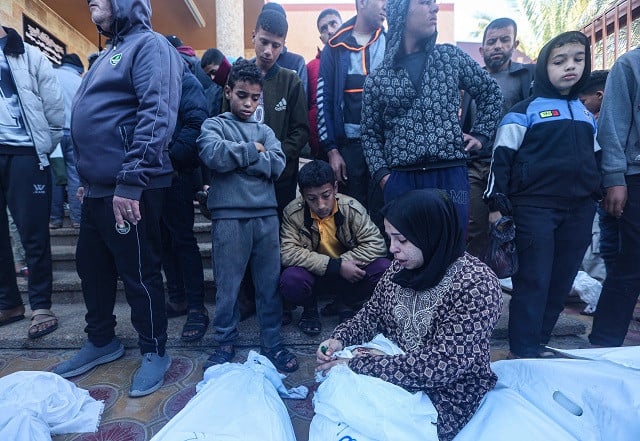—— Deadly Israeli air strikes targeting UN school, homes in Gaza claim 12 more lives
—— Heavy exchange of fire being reported from Rafah as Gaza’s death toll reaches close to 19,000
—— Dutch court dismisses human rights groups’ demands seeking block to export of F-35 fighter jet parts to Israel
DM Monitoring
GAZA: Al Jazeera reported on Friday that at least 12 people were killed in Israeli air strikes on a UN school in Khan Younis and homes in southern Gaza.
The Palestinian telecommunications firms further reported that Gaza was under another communications blackout due to Israeli attacks. The besieged enclave’s media office reported that the blackout was hampering the rescue efforts even more.
To add to this bleak picture was Al Jazeera’s Hani Mahmoud’s report that intense firing could be heard in the eastern part of Rafah, where millions of displaced Gazans were repeatedly ordered to move to for ‘safety’.
As per the latest casualty figures at least 18,787 people have been killed in Gaza, whereas a staggering 50,897 are injured. Furthermore, Israeli violence has claimed the lives of 289 Palestinians residing in Occupied West Bank, and injured 3,365.
The total number of Israelis killed in the October 7 Hamas attack stands at 1,200, after being revised down from 1,400. Around 8,730 Israelis are said to be wounded. According to the Israeli army, at least 448 of its soldiers have so far been killed in the retaliatory operation that it launched in the aftermath of the October 7 attack.
Reuters said on Friday that witnesses informed of Israeli forces and Hamas engaging in fierce battles throughout Gaza, suggesting Israel’s ground offensive was meeting stiffer resistance as the US nudged its ally to change a strategy that has inflicted a huge civilian death toll.
Residents in the small enclave reported fighting in Sheijaia, Sheikh Radwan, Zeitoun, Tuffah, and Beit Hanoun in north Gaza, east of Maghazi in central Gaza and in the centre and northern fringes of the main southern city of Khan Younis.
Hospitals in Deir al-Balah, Khan Younis and Rafah reported a new influx of dead and wounded early on Friday including two children. Four people were killed in an Israeli air strike on a house in Rafah and Israeli tanks were shelling targets just east of the city near the Egyptian border, medics and witnesses said. The Israeli military said in an update on Friday its forces had destroyed a Hamas command and control hub in Gaza City’s heavily contested Sheijaia district and conducted a “targeted raid” on militant infrastructure in Khan Younis.
The heavy fighting, confirmed by many residents and militant sources reached by Reuters, raised questions about whether Israel’s two-month-long aerial and ground blitz of Gaza had significantly weakened Hamas, which it has vowed to annihilate.
“The Gaza Strip turned into a ball of fire overnight, we could hear explosions and gunshots echoing from all directions,” said Ahmed, 45, an electrician who was speaking to Reuters from a shelter in a central area of the densely populated coastal strip.
“They can destroy homes and roads and kill civilians from the air or through blind tank shelling, but when they come face to face with the resistance, they lose. We don’t have anything to lose after all they had done to our Gaza,” he said.
Unrelenting Israeli bombardment has laid much of Gaza to waste over the past two months, with nearly 19,000 people confirmed dead, according to Palestinian health officials, and thousands more feared buried under the rubble.
Israel launched its onslaught in retaliation for the surprise cross-border October 7 attack by Hamas.
Israeli Prime Minister Benjamin Netanyahu told visiting White House national security adviser Jake Sullivan on Thursday that Israel would be at war with Hamas “until absolute victory”. This, Defence Minister Yoav Gallant said, “will last more than several months – but we will win and we will destroy them”.
There has been no sign of a halt in the hostilities, with Israeli assertions in late November to have largely subdued the heavily urbanised north of Gaza appearing to be a chimera.
The spread of ground war after a week-long pause that enabled the release of some hostages has frustrated plans to step up deliveries of desperately needed basic supplies for civilians to survive as their homes have been destroyed.
Over 80 percent of Gaza’s 2.3 million people have been displaced, some repeatedly. Washington has been pressing Israel for weeks to do more to protect Gaza’s civilians as a global outcry over a spreading humanitarian catastrophe, with medical care crippled and food, fuel and drinking water widely unavailable, has intensified.
US National Security Adviser Jake Sullivan had talks with Israel on Thursday about shifting its military strategy in Gaza from a broad ground offensive toward precision strikes against Hamas to better protect civilians from harm.
“There was a discussion in these meetings and also in our prior meetings, and in calls between the President (Joe Biden) and (Israeli) Prime Minister (Benjamin Netanyahu), on kind of a shift in emphasis from high-tempo clearance operations, high intensity clearance operations, which are ongoing now, to ultimately lower-intensity focus on high-value targets, intelligence-driven raids, those sorts of more narrow, surgical military objectives,” said a senior US administration official who asked not to be identified.
But it would be “irresponsible” to give specific time frames for such a change, the official said in a briefing to reporters about Sullivan’s visit to Israel.
Israel says Hamas uses civilians and civilian buildings as shields, an allegation it denies, but allies and adversaries alike, as well as the UN and humanitarian and rights groups, say Israel has done far too little to protect civilians.
Tens of thousands of homeless Gazans who have crammed into Rafah at Gaza’s southern end since December 3 are struggling in extremely overcrowded conditions, with the lack of latrines forcing many to defecate in the open, raising disease risks, the UN Humanitarian Office (OCHA) said in an update on Friday.
In many locations, solid waste was piling up without a safe means of disposal, and rats and insects were congregating in these areas, OCHA said.




